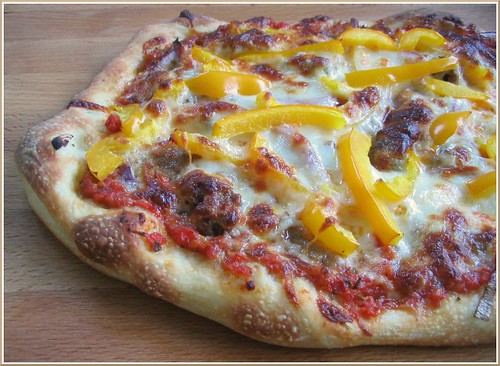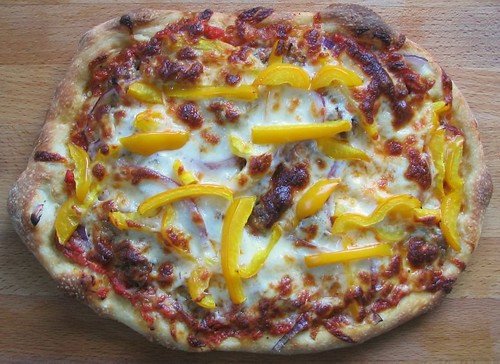
Once upon a time, I tried to make pizza... on a cookie sheet... in a 350 degree oven. To put it bluntly, the end result was bad. The "crust" ended up being about an inch thick, soggy where it touched the sauce, soft and flabby on the bottom like it was steamed rather than baked. It barely qualified as a crust, I probably can't even use that word to describe this monstrosity. I think I found on the recipe, which seemed fairly legitimate at the time, on the Food Network being pass off as making a decent pizza. It was completely ridiculous! Now I know better; now I know that high heat is critical for a crisp crust and a baking stone really helps. I'm not
Steven always hangs out with me in the kitchen when I make pizza. Whether he's there to keep me company or to steal little bits of cheese or Italian sausage when I'm not looking, I'm not really sure, though I suspect it's a bit of both. Homemade pizza is always really rewarding. We can choose what toppings and just how much of them we want to put on and how thin or thick we want the crust so our pizzas are always just the way we like them. And the pizza bakes really quickly so it's really entertaining to see it transform in the oven in a matter of minutes.
Notes:
- I included 2 dough recipes. The first is the regular pizza dough from Cook's Illustrated. The second is also from Cook's Illustrated but it's the pissaladiere dough recipe. You'll notice that the first recipe uses 4 cups of flour and 1 3/4 cups of water while the second uses 4 cups of flour and 2 cups of water. Since the second recipe has more water it makes a crispier crust. I experimented with both and personally liked the pissaladiere dough more. I recommend trying both out and seeing which you prefer. You can always opt to make a half recipe to test it out.
- I usually divide the dough in half, freeze one portion and make 2 medium pizzas out of the second portion (smaller pieces of dough are easier to work with). This is plenty for both Steven, a voracious pizza eater, and I, with a bit leftover.
Pizza Dough (Yields 3 - 4 medium pizzas or 2 larges, serves 4 - 6)
Adapted from Cook's Illustrated
4 C bread flour (plus more for dusting)
1 3/4 C warm water, about 110ºF
1 package instant yeast, about 2 1/4 tsp
2 Tbsp olive oil (and more for hands)
2 tsp salt
If you are using instant yeast you can skip the proofing, but if you are using active dry yeast, proof the yeast in the warm water for 10 minutes then proceed with making the dough.
Mix the flour with yeast and salt in the bowl of a stand mixer. Pour in the warm water and olive oil and use the paddle attachment to bring the dough together at low speed. Then switch to the dough hook and knead for 5 minutes, until the dough is smooth and elastic. The dough will be a little sticky but if it's too sticky add some more flour, about a tablespoon at a time. The dough can also be made in a food processor (in a matter of seconds) or by hand.
Place the dough in a lightly oiled bowl and cover with plastic wrap. Let it rise until doubled, about 1 1/2 to 2 hours.
Gently turn the dough out onto a lightly floured work surface. I find it's easiest to work with medium sized pizzas so either divide the dough into 3 or 4 pieces (or alternatively you can make 2 large pizzas).
One trick I learned when making pissaladiere, is to oil your hands instead of flour them. First stretch out the dough into the desired shape then use your palms and press out the dough to stretch and flatten it more, at the same time you press olive oil into the dough for a crispy crust. It also saves you the step of having to brush olive oil on the dough.
I don't like to roll out pizza dough because it squeezes out all the bubbles, I like the bubbles. Instead I stretch out the dough with my hands or hang it over my fists and gently stretch out the dough while gravity helps out. If the dough resists, let it rest for about 10 minutes, then stretch it some more. Then I coat my palms in some olive oil and press the dough outwards to get it even thinner.
Remember to preheat your pizza stone to 500ºF or the highest temp your oven will go 30 minutes before you want to bake your pizza.
~~
Pissaladiere Dough - Extra Crispy Pizza Dough (Yields 3 - 4 medium pizzas, serves 4 - 6)
4 C bread flour
2 tsp instant yeast, you can probably just use a packet since that's 2 1/4 tsp
2 tsp salt
2 Tbsp olive oil
2 C warm water, about 110ºF
If you are using instant yeast you can skip the proofing, but if you are using active dry yeast, proof the yeast in the warm water for 10 minutes then proceed with making the dough.
The dough is easiest made in the food processor because it is very wet and sticky but you can also use a stand mixer or mix it by hand.
Add the flour, yeast, and salt to the food processor and pulse a few times to combine. With the motor running, add the oil then steadily pour in the water and process until the dough comes together in a ball, about 15 seconds. The plastic dough blade works best for the dough, but I only have a mini food processor and a metal blade so I have to make the dough in batches then combine the pieces together.
Flour your hands and dust a work surface and knead the dough a bit. But since this is a very wet dough, it's more of a slap/push than a gutsy knead. Shape the dough into a ball. The dough will be wet, sticky. It will be pretty sticky and stick to your hands a bit, but not a lot, and very slack.
Place the dough in a lightly oil a bowl and cover with plastic wrap. Let it rise in a warm place until doubled, about 1 hour to 1 1/2 hours.
When the dough has doubled, gently turn it out of the container. Cut it into 3 or 4 even pieces and form each piece into a ball by gently picking the edges of the dough together into a pouch and pinch to close. Roll the dough ball over, seam side down. Cup the dough with both hands and push the dough around to form a taut ball. Repeat for the remaining pieces. Brush each piece lightly with olive oil, cover with plastic wrap, and set aside for 10 minutes for the second rise.
Coat your hand in oil instead of flour. Pick up the dough and stretch the dough into a rough circle. Place the dough on a sheet of parchment then using the palm of your hand, push the dough out into an circle. The surface should be evenly flat but leave a small lip around the dough for the crust.
~~
Quick Tomato Sauce (makes about 3 cups of sauce, enough for the full dough recipe)
1 28 oz. can diced or whole tomatoes, pureed in a FP or blender or put through a food mill
2 tbsp olive oil
2 - 4 garlic cloves, minced or pressed
salt and pepper
a few pinches of Italian herb mix, crushed between your fingers
About 1/2 C fresh basil leaves, chopped or chiffonade
Add garlic and olive oil to a (unheated) saucepan or skillet and heat them up together over medium heat. When the garlic starts sizzling and smells fragrant (don't burn it), add the tomatoes, pepper, and some italian herb mix. Simmer uncovered until the sauce is thickened.
Season to taste with salt and stir in the basil off heat.
~~

Italian Sausage and Pepper Pizza (makes 2 medium pizzas)
Half a pizza dough recipe
Half the quick tomato sauce recipe, about 1 1/2 C
1/2 red onion, sliced
3 Italian sausages, removed from casing
1 medium red, orange, or yellow bell pepper, sliced
About 1 C shredded mozzarella
Preheat the pizza stone and oven to 500ºF or the highest your oven will go. Remember to place the stone into a cold oven and heat them up together.
Brown the Italian sausages in a skillet over medium heat until cooked through (important), breaking into bite size pieces.
Divide the dough in half. Stretch out and flatten the crust. Crack some pepper on the dough and spread about 3/4 C of tomato sauce onto it.
I like to put the sausage pieces and onion slices on first and hide these toppings under the cheese so they don't burn. Then put the peppers on top so they can roast in the oven.
Bake until the crust is golden brown and the cheese is spotty and melted, about 5 to 10 minutes depending on your oven. Keep an eye on it and remove it when you think it looks good.



0 komentar:
Post a Comment